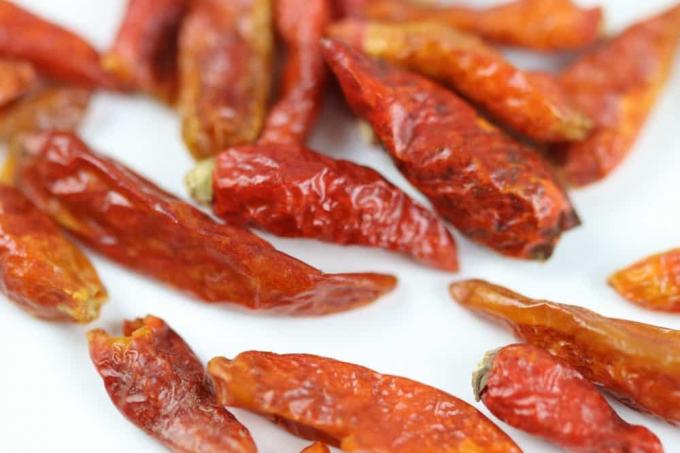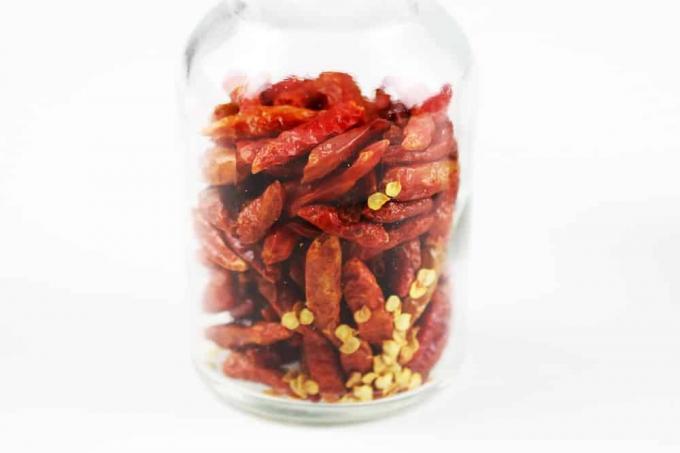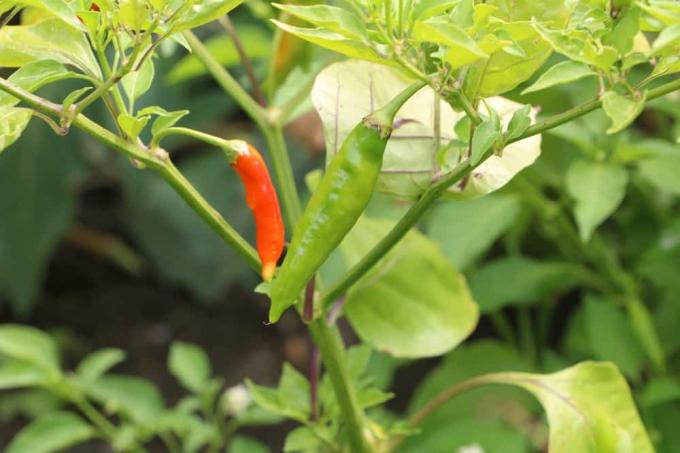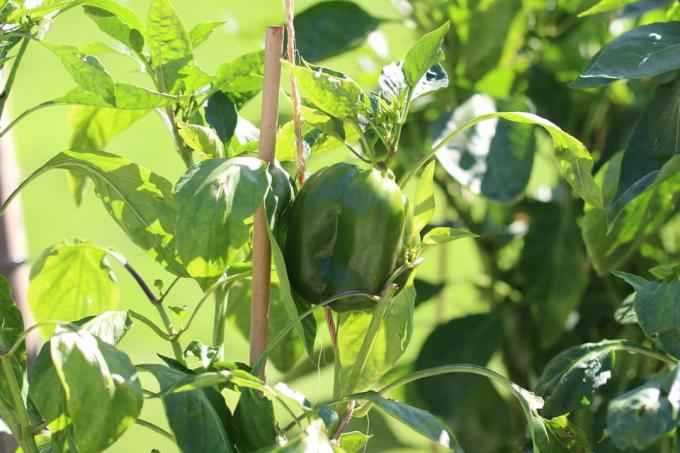

Table of contents
- chillies
- Location
- sowing
- plant out
- Cultivation in the bucket
- Care
- harvest
- drying
It doesn't matter whether it's cayenne pepper, paprika or chili peppers - it always means chili plants. Its pod-like fruits have become indispensable in modern cuisine. It goes without saying that you are also thinking about growing it in your own garden. Chili cultivation is relatively easy and often results in a bountiful harvest. If you like it hot and love fascinating plants, you can't avoid it.
chillies
Chili plants originally come from Central and South America, but are now cultivated in many parts of the world. They belong to the nightshade family. Its general Latin name is Capsicum annuum. Above all, the plants need warmth and a rather tropical climate to grow and thrive. However, cultivation outside of greenhouses is also possible in this country if you follow a few basic rules. If the conditions are right, the plants grow up to 80 centimeters tall and mostly form pod-shaped fruits, which in turn can be up to 30 centimeters long depending on the species. Chili plants are extremely easy to care for and relatively undemanding. As a rule, you can expect a large harvest, which in any case more than covers your own needs.
Location
Since Capsicum annuum is originally native to very warm regions, the plants absolutely need a sunny spot in the garden. Incidentally, this also applies if you cultivate them in a planter. Warmth and plenty of sun are, in a sense, the basic requirements for being successful when growing chillies. So, before you decide to start doing it, you should check the site conditions very carefully. Under normal circumstances, of course, there is a suitable spot in almost every garden. Alternatively, of course, cultivation in a greenhouse is always possible. Under certain circumstances, chilli plants also thrive in a very sunny location in the apartment. However, if you decide to cultivate in a bucket, it is better to put them on the terrace or balcony, as the plants can get very large.
A notice:
Chili plants do not tolerate frost and may therefore only be brought outdoors when night frosts can definitely be ruled out.
sowing

Before the chillies can of course be brought to their final location, they first have to be sown. In principle, you can also buy young plants in garden shops or hardware stores. However, it is more satisfying and, in most cases, happier to work with seeds. You can either buy it in stores or get it from ripe chili peppers - regardless of whether you got them from the supermarket or from your own garden. Sowing is always done in planting or propagation trays. It is important that it takes place very early in the year. January has proven to be ideal. The following must be observed:
- Conventional, relatively nutrient-poor potting soil is suitable as a substrate, which should be mixed with perlite for better air permeability
- The room temperature should be more or less constant around 25 degrees Celsius
- The plant substrate is kept moist, but no waterlogging should occur
- It takes about a week or two for the seeds to germinate
As soon as the seedlings have developed the first leaves above the ground, they can be transplanted into larger planters, but of course they still have to be kept indoors or outdoors. remain in the apartment. Even the young plants need a lot of light. A sunny location by the window is therefore an absolute must. However, they should be slowly acclimated to the sun.
Tip:
If you don't have plant bowls, you can also use empty and well-cleaned yoghurt pots or other such containers. It is advisable to provide them with holes to avoid any waterlogging.
plant out
The young chilli plants can only be brought outdoors when there is no longer any risk of ground frost. As a rule, this should be the case by mid-May at the latest. The plants are removed from their containers and planted in the soil in a bed. The best way to do this is to dig out a small hollow with your hand or a garden shovel. When planting, it is important that the entire leafless part of the stem disappears under the ground. The soil should have been enriched with compost and perlite beforehand. Then the soil is lightly pressed and watered well. It may be advisable to use a plant stick right from the start, to which the chillies are best tied with raffia to give them more stability. If several chilies are planted, the distance should be at least 40 centimeters.
Cultivation in the bucket
Those who prefer to cultivate their chili plants in a planter can do so relatively easily. Since the chillies impress with their wonderful flowers and later with their colorful fruits, the plants are of course perfect as eye-catchers for the balcony or terrace. Of course, the planter and the plant substrate are of great importance in tub cultivation. The vessel must have a drain hose for the water. In addition, a drainage made of gravel or potsherds should be created. The plant substrate, in turn - preferably conventional garden soil - is ideally enriched with compost and perlite. Otherwise, the same principles apply to keeping chillies in buckets as they are to cultivation in the garden. The location must therefore definitely get a lot of sun.
Care

As already mentioned, chili plants are extremely easy to care for and undemanding. So you won't have much work with them. Watering is clearly the focus of maintenance. The following applies: watering should be done daily. We recommend using only soft water. Rainwater that you have previously collected in a bin is ideal. Don't underestimate the water needs of plants. Especially in midsummer, chillies drink away a lot. The soil around the plant stem should always be kept moist. When casting, the following rules have proven to be very effective:
- The ideal watering time is in the evening hours
- It must not be poured under direct sunlight (midday sun).
- Always water generously, but avoid waterlogging at all costs
Of course, care also includes regularly checking the plants for pests. In any case, the check should be carried out twice a week. And you can't do it without fertilizer either. Conventional fertilizer for tomato plants, which can be administered every two weeks, is recommended here. However, a cut is not required. To get to the point again: If the location is right, caring for the chillies is child's play and quickly done on the side.
harvest
It takes a while until the fruits of the chili plants are ripe and can be harvested. As a rule of thumb, maturity is sufficient from the end of August. However, this cannot be applied across the board. It may well last into October. It's not just about the ripeness itself, but also about the taste. For him, in turn, it is crucial how much sun the plants have received: the more sun, the more taste. A clear sign that it can and should be harvested now is when the pods on the plant begin to shrivel. The pods should never be simply torn off. It is much better to cut them off the plant by the stem with secateurs.
Tip:
When harvesting chili peppers, it is advisable to wear gloves and possibly safety goggles so that you do not become a victim of the pungency of the fruit.
drying

Chili peppers can be used in a variety of ways. Either you eat them raw immediately after harvesting or cook them or freeze them for later use. Waking up is of course also possible. However, one of the most popular methods is now drying the pods. It should be noted, however, that this is not the case with every type or variety is possible without any problems - unless you use a dehydrator. In principle, only thin-fleshed pods are suitable for drying in the air. These include the following varieties:
- cayenne
- Hot Cayenne
- Tabasco
- Dutch Red
- Great chili
To dry, the individual pods are simply hung up by their stalks on a stretched cord. So the principle of the clothesline is used. The line should be stretched in a dry, warm and shady location. There should also be a constant draft there. Caution: Wetness and moisture are absolutely harmful and naturally stand in the way of the drying process! All in all, it takes about three to six weeks for the drying to be complete. The pods are then removed and stored as cool and of course absolutely dry as possible. Small, open baskets are recommended for storage. Plastic bags, on the other hand, are not suitable for this because condensation can form in them very easily.
 garden editorial
garden editorial I write about everything that interests me in my garden.
Find out more about paprika, chili & Co

Grow peppers yourself from seeds: instructions
Growing peppers yourself is easy, because the popular vegetable can easily be propagated from seeds. In this article you will find out how the sowing works best.

12 good neighbors of peppers | mixed culture
The Germans love peppers. On average, more than four kilograms are consumed per person per year. In the garden, the vitamin-rich vegetable thrives in sunny spots. If you choose the right plant neighbors, you can look forward to a high yield.

Sowing peppers: sowing according to the lunar calendar 2023
Red, yellow or green, pointed or round, mild or hot, paprika is one of the most popular types of vegetables. Would you like to grow the healthy vegetables in your own garden? If you pay attention to the needs of the plant and the lunar calendar, you will benefit from a rich harvest!

Cut/pinch out the pepper plant | 5 tips for pruning
Sweet, hot, pointed or plump, which hobby gardener does not like them, the crispy fresh or fiery peppers. Be it the mildly fruity sweet peppers or the spiced peppers with different degrees of spiciness. Cultivation and care are the same. There is only a small difference in the cut.

Chili cultivation: Instructions for sowing and pricking out
If you want to harvest interesting chili instead of boring peppers, you have to grow the young plants yourself. Seeds are available cheaply in stores, and specialized online shops in particular are well stocked. After that, it's just a matter of taking the right step at the right time.

Prick the peppers: Instructions | Soil and pot size basics
To germinate, many pepper seeds may be close together. But as soon as the seedlings rise from the ground and form the first green leaves, they should be separated from each other. Transplanting them into their own pots gives them more space and therefore better growing conditions.



